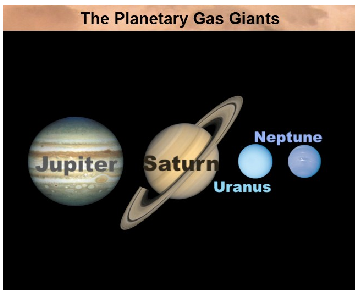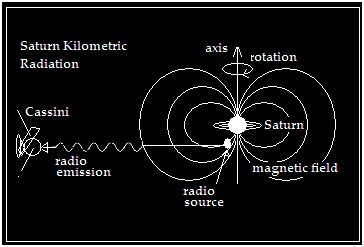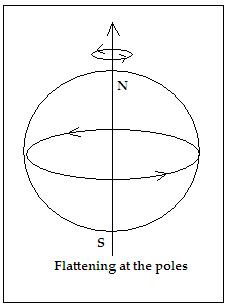We cannot tell that a mass of gas is turning round just by looking at it says S.Ananthanarayanan.
The rotation of planets can generally be made out in the telescope because we see physical features that regularly move out of view at one end and come back into sight from the other. Even of stars, we are able to make out and estimate rotational motion with the help of related effects, like the fact that the star has not collapsed due to gravity, which can be observed. But when it comes to the gas planets, like Jupiter or Saturn, there are neither surface features that can be seen, nor other indicators, like those of stars.

In the case of Jupiter, although what we can see is only gas and clouds, there is still a magnetic axis which is inclined to the axis of rotation. The rotation of the planet can thus be made out, because the direction of the magnetic field is as good as a pointer, or a direction marker, which goes round as the planet rotates. But in the case of Saturn, the second largest of the four gas planets, its magnetic axis is aligned almost along its axis of rotation. The magnetic field is thus not appreciably affected by rotation and it does not serve to make out how fast the planet goes round.
Estimates of the period of rotation of Saturn have hence been possible only by listening to low frequency radio signals that come from the planet and this had to wait till the spacecraft, Voyagerand Cassini, were able to fly past and make close range observations. The source of radio signals is the movement of charged particles that arise within the planet or in its atmosphere as a result of solar radiation. The planetís magnetic field twists the motion of these particles into spirals, and such motion of charged particles leads to radio emission. But as the orientation of the magnetic field itself is changing, the intensity of radio emission rises and falls, in keeping with the changes in the magnetic field. Observation of the Saturn Kilometric Radiation (SKR), as the radiation from Saturn is called, was hence treated as a reliable method of assessing the rate of rotation.

Except that the rate revealed by Cassini, which went into orbit around Saturn in 2003, was both variable and six to eight minutes slower than what Voyager measured in 1980-81. As the time for a rotation estimated is around 10 hours and forty minutes, this difference is considered quite large and raises questions about SKR being suitable method at all. Further estimates, based on other data, like wind speeds, dimensions and measurement of Saturnís gravitational field by Cassini, have resulted in rotation time lesser even than the estimate by Voyager, and a basic property of a major planet in our own system is still uncertain. But Ravit Helled, Eli Galanti and Yohai Kaspi, of Tel Aviv University and Weizman Institute of Sciences, Israel, report in the journal, Nature, that they have worked it out with a statistical, opitimization method, based on Cassini data of the gravitational field of Saturn, and not the orientation of the magnetic field. And when they use the same method, using gravitational effects, to work out the rotation period of Jupiter, which is already known, they find that the answer agrees!
Gravitation data
The principle of using gravitational data to work out the rate of rotation depends on the rotating body not being uniform in all ways. We can readily imagine that the energy of rotation of a wheel that has most of its mass in the centre is not the same as that of a wheel with its mass at the rim. This is the principle of the flywheel and the ballerina, or ice skater, who pulls her arms in to spin faster. Thus, if the composition of a wheel were not known to us, we could still work it out by measuring what effort it takes to set the wheel spinning. In the case of gravitational forces also, the radial distribution of density, or the oblate shape, which is where the poles are flatter, in a sphere, like a planet, have their own effect on the force of gravity as one moves nearer or further away from the sphere. And then there are the effects of variation in density, like composition of the crust or deeper within the planet, or the presence of mountains or oceans.

The effect of these variations is felt by a satellite in orbit around a planet, pulling out away from the planet where the gravity is weaker, or inwards, and speeding up, if the gravity is stronger. The data of the variations in the gravitational force of Saturn, as measured by Cassini, over a period, with assumptions about the interior of the planet, can hence be interpreted to provide a measure of the flattening, or the bulge around the equator, and hence the speed of rotation of the planet
Making use of the gravity data of Cassini and other data then available, John D. Anderson Gerald Schubert, of California reported in the journal, Science, in 2007, that they have arrived at the lower limit, which is 10 hours 32 minutes and 35 seconds, which we spoke of earlier. The group from Israel now reports a figure that is very close to this one, based again on the gravitational data, and a statistical methodology, using 2,000 situations, to arrive at the best value of speed of rotation which fits the other, uncertain models of the internal density distribution.
To check the validity of the procedure used, the group has employed the same method, based on gravitational data, to work out the speed of rotation of the planet, Jupiter. As mentioned earlier, in the case of Jupiter, we have the clear marker of the magnetic axis well removed from the axis of rotation, and we know the speed of rotation with certainty. And the result of the check is that the gravitation data method accurately arrives at the same, known value of the speed of rotation of Jupiter.
That two independent determinations of the speed of rotation give results in close agreement thus means we now have the length of a day on Saturn. The Israel group anyway awaits more accurate data from Cassini, in the course of its extended stay around Saturn, till 2017, for a more exact estimate.
------------------------------------------------------------------------------------------